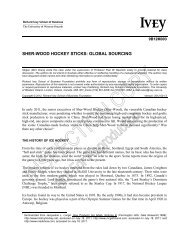foundation of canada asia pacific - Content Tagged with
foundation of canada asia pacific - Content Tagged with
foundation of canada asia pacific - Content Tagged with
You also want an ePaper? Increase the reach of your titles
YUMPU automatically turns print PDFs into web optimized ePapers that Google loves.
October 2000, we will hold the first Asia Pacific Summit at Simon Fraser University’s<br />
Centre for Dialogue in downtown Vancouver. The centrepiece <strong>of</strong> the facility — the<br />
Asia Pacific Hall — is the physical legacy <strong>of</strong> Canada’s Year <strong>of</strong> Asia Pacific in 1997, and a<br />
fitting venue for the launch <strong>of</strong> what we hope will, over time, be recognised as a<br />
premier Asia-Pacific conference.<br />
Our efforts <strong>with</strong> the new media and the Asia Pacific Summit are extensions <strong>of</strong> something<br />
we have been doing <strong>with</strong> “old” media since 1996. Canada Asia Review remains our flagship<br />
print publication and we have used it to promote debate on key aspects <strong>of</strong> Canada-Asia<br />
relations. This year is no different. You will find in this issue regular features such as the<br />
year in review, the Canada Asia Report Card, and an expanded statistical annex on Canada-<br />
Asia relations.The rest <strong>of</strong> the document is organized around the theme <strong>of</strong> globalization<br />
and its implications for Canada-Asia relations.<br />
5<br />
In choosing this theme, we are consciously placing Canada-Asia relations in the larger<br />
context <strong>of</strong> Canada’s place in the global economy. We do so because the everyday choices<br />
that are made by Canadian businesspeople, policymakers and individual consumers are<br />
rarely based on narrow categories such as Canada-Asia relations, but are influenced by a<br />
range <strong>of</strong> diverse factors, some more parochial than others. We cannot advance our<br />
understanding <strong>of</strong> Canada-Asia relations <strong>with</strong>out understanding the larger context <strong>with</strong>in<br />
which the relationship exists. For example in Chapter 4, rather than simply asking how<br />
to enhance Canada-Asia economic relations, we look at what closer economic integration<br />
<strong>with</strong> the United States means for Canada-Asia ties, and whether it is in our interest to<br />
resist certain forms <strong>of</strong> even closer integration <strong>with</strong> the US. Likewise in Chapter 6, we<br />
look at the implications <strong>of</strong> globalization for all kinds <strong>of</strong> government international cooperation<br />
activities, rather than just at Canadian aid to developing Asia as a self-contained policy<br />
category called “development assistance.”<br />
One <strong>of</strong> the underlying messages in this year’s Canada Asia Review therefore is that Canada-<br />
Asia relations is not some rarefied field for Asian specialists to debate in musty seminar<br />
rooms. Rather, it is nuts and bolts issues — trade, investment, aid, immigration, tourism,<br />
study abroad, peace and security — that affect and are affected by mainstream concerns<br />
in Canada. The Foundation is committed to helping Canadians better understand the<br />
relevance <strong>of</strong> the Asia Pacific to their lives and to ensuring that Canada benefits from this<br />
understanding.<br />
I hope you find Canada Asia Review 2000 stimulating reading.<br />
Dr. John D. Wiebe<br />
President and CEO<br />
Asia Pacific Foundation <strong>of</strong> Canada



